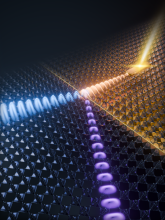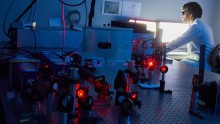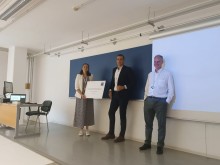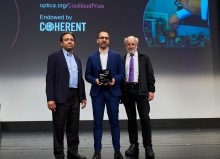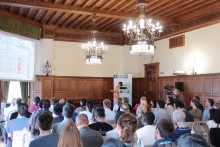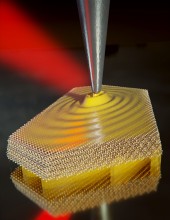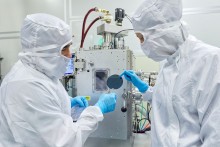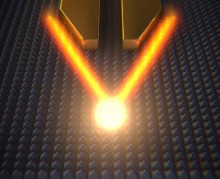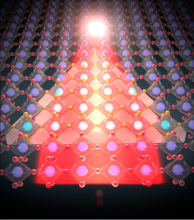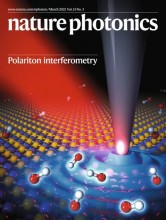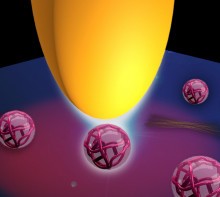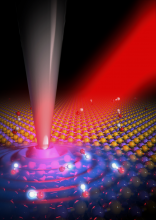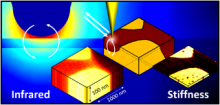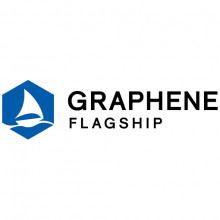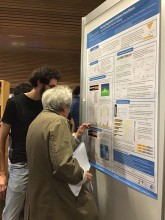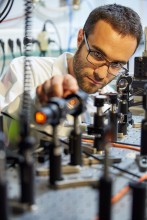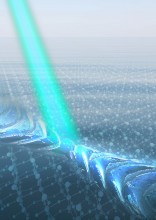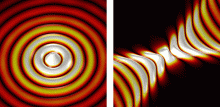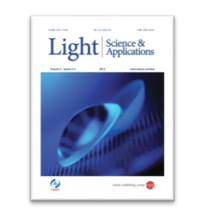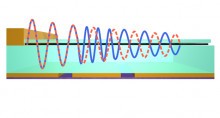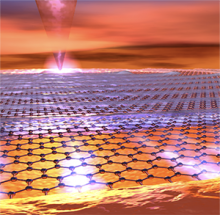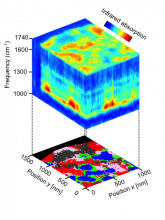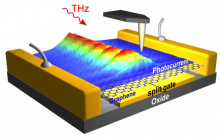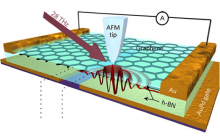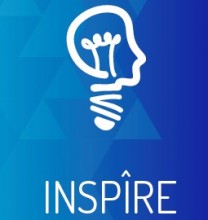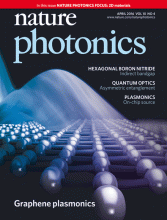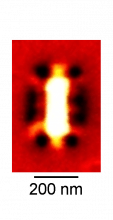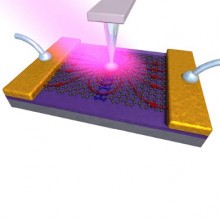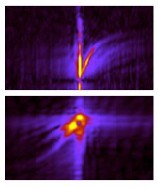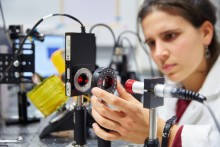Nanooptics News
Últimas noticias
Researchers Observe Flat-Band Ultrastrong Coupling
Two-step excitation unlocks and steers exotic nanolight
Review Article Highlights 25 Years of Modern Near-field Optical Nanoimaging
A newly published review article in Nature Reviews Materials highlights the groundbreaking impact of scattering-type scanning near-field optical microscopy (s-SNOM), a technique that surpasses the diffraction limit to achieve nanoscale optical imaging across a broad spectral range. Authored by leading experts in...
Scientists synthesize 2D polyaniline crystal with unique metallic out-of-plane conductivity
In a recent study published in Nature, an international team of researchers in which nanoGUNE scientists participate has developed a groundbreaking two-dimensional conducting polymer—polyaniline (2DPANI)—that exhibits exceptional electrical conductivity and metallic charge transport behavior. Unlike conventional...
María Barra recibe el premio Nanolito por su Tesis Doctoral
Edoardo Vicentini, ganador del premio Bernard J. Couillaud 2023
CIC nanoGUNE organiza la primera escuela de verano de Nanoscopía Óptica de Campo Cercano
"Cuando desarrollamos las herramientas de nanoimagen óptica s-SNOM y nano-FTIR, nunca pensé que pudieran tener un potencial de aplicación tan amplio", afirma el Profesor de Investigación Ikerbasque Rainer Hillenbrand cuando es preguntado por la evolución de su campo de investigación. Esta semana, del 6 al 9 de...
Researchers observe extremely squeezed directional THz waves in thin semiconductor crystals
An international team of scientists from the Basque research center CIC nanoGUNE, Shanghai University for Science and Technology, Fudan University (Shanghai), Brno University of Technology, University of the Basque Country, Materials Physics Center (CSIC-UPV/EHU), Donostia International Physics Center and the Max...
Abierto el plazo de inscripción del programa de prácticas de verano
Researchers develop an innovative strategy to focus infrared light into the nanoscale
An international team of researchers, including members of nanoGUNE's Nanooptics group, publish in “Science Advances” the grounds for the realization of nanodevices that, based on the manipulation of light at the nanoscale, promise the development of extraordinarily sensitive biosensors. The researchers also...
Review: Interface nano-optics with van der Waals polaritons
An international team, including the leader of the Nanooptics group at nanoGUNE, Rainer Hillenbrand, discusses in ‘Nature’ the state-of-the-art and opportunities for controlling the propagation of nanolight (in form of polaritons) in van der Waals materials with the help of classical refractive optics...
Review: Nanoscale terahertz scanning probe microscopy
Four international experts, including the leader of the Nanooptics group at nanoGUNE Rainer Hillenbrand, analyze in ‘Nature Photonics’ the terahertz scanning probe microscopy techniques that achieve spatial resolution on the scale of micrometres to ångströms, with particular emphasis on their overarching approaches...
Understanding nanolight refraction on highly anisotropic materials
An international team of researchers, including members of nanoGUNE's Nanooptics group, unveils in ‘Nature Communications’ fundamental aspects of nanolight refraction in highly anisotropic media. The researchers also report the design of a new planar nanolens 1000 times smaller than the thickness of a human hair,...
Una investigación de CIC nanoGUNE sobre la luz, portada en la revista Nature Photonics
Investigadores del CIC nanoGUNE, en colaboración con el Donostia International Physics Center (DIPC) y la Universidad de Oviedo, emplearon una técnica de nanoimagen espectroscópica para estudiar cómo interactúan la nanoluz infrarroja -en forma de polaritones fonónicos- y las vibraciones moleculares. El trabajo...
Las nanopartículas como portadores de fármacos
Vibrational Encounters – Phonon Polaritons Meet Molecules
Researchers from CIC nanoGUNE BRTA (San Sebastian, Spain), in collaboration with the Donostia International Physics Center (San Sebastián, Spain) and the University of Oviedo (Spain) employed a spectroscopic nanoimaging technique to study how infrared nanolight - in form of phonon polaritons - and molecular...
nanoGUNE reaches new depths in infrared nanospectroscopy
Researchers from the Nanooptics Group at CIC nanoGUNE demonstrate that nanoscale infrared imaging – which is established as a surface-sensitive technique – can be employed for chemical nanoidentification of materials that are located up to 100 nm below the surface. The results further show that the infrared...
Cómo manipular la luz en la nanoescala en amplios rangos de frecuencia
Un equipo internacional liderado por investigadores de la Universidad de Oviedo y del Centro de Investigación en Nanomateriales y Nanotecnología (CINN-CSIC), junto con científicos de los centros de investigación vascos CIC nanoGUNE, Donostia Internatioanl Physics Center (DIPC), Centro de Física de Materiales (CFM,...
CIC nanoGUNE works on infrared sensing and photodetectors within GrapheneCore3
The Nanooptics Group of CIC nanoGUNE is involved in the Work Package 8: Photonics and Optoelectronics in the Graphene Flagship Core 3 project, the fourth funding cycle of the €1 Billion research initiative funded by the European Commission. The mission of Work Package Photonics and Optoelectronics is to develop GRM...
nanoGUNE PhD Workshop 2020
nanoGUNE lanza una nueva convocatoria de prácticas de verano para universitarios
Researchers discover directional and long-lived nanolight in a 2D material
An international team led by researchers from Monash University (Melbourne, Australia), University of Oviedo (Asturias, Spain), CIC nanoGUNE (San Sebastián, Spain), and Soochow University (Suzhou, China) discover squeezed light ('nanolight') in the nanoscale that propagates only in specific directions along thin...
Apply for a Basque PhD grant with nanoGUNE
NanoGUNE, located at the Ibaeta Campus of the UPV/EHU in Donostia – San Sebastián, offers PhD opportunities to graduates in Physics, Chemistry, Engineering, Biology, and related areas to get their PhD degree.
Phononic SEIRA - Enhancing light-molecule interactions via crystal lattice vibrations
Researchers from CIC-nanoGUNE (San Sebastián, Spain), in collaboration with the Donostia International Physics Center (San Sebastián, Spain), Materials Physics Center (CFM, CSIC-UPV/EHU, San Sebastián, Spain) and University of Oviedo demonstrate a new way to strongly couple infrared light and molecular vibrations,...
Investigadores vascos ponen la luz “patas arriba”
Boron nitride nanoresonators for phonon-enhanced molecular vibrational spectroscopy at the strong coupling limit
NewsTest
NewsTestintrotext
Ultra-compact phase modulators based on graphene plasmons
Quantum nanoscope
A new dimension in chemical nanoimaging
Researchers from the Basque institutions CIC nanoGUNE, Ikerbasque and Cidetec, and the German Robert Koch-Institut report the development of hyperspectral infrared nanoimaging. It is based on Fourier transform infrared nanospectroscopy (nano-FTIR) and enables highly sensitive spectroscopic imaging of chemical...
Detección eléctrica de plasmones de grafeno a frecuencias de terahercios
Un grupo de investigadores ha desarrollado una nueva técnica para visualizar fotocorrientes en la nanoescala, y la ha aplicado para observar ondas electromagnéticas extremadamente comprimidas (plasmones) a frecuencias de terahercios en un fotodetector de grafeno. Tanto la longitud de onda extremadamente corta de...
Graphene does double duty for plasmons
El proyecto CENTINELA ganador del programa Inspire
Petronor ha presentado esta semana el primer balance del convenio con el departamento de Desarrollo Económico y Competitividad del Gobierno Vasco y los tres proyectos ganadores del programa de innovación abierta Inspire, entre los que se encuentra el proyecto CENTINELA elaborado por el Centro de Física de...
Investigadores de nanoGUNE lideran una investigación sobre el grafeno portada en Nature Photonics
Investigadores del CIC nanoGUNE, en colaboración con ICFO y Graphenea, han visualizado por primera vez la luz infrarroja en nanoestructuras de grafeno. Este trabajo abre el camino para nuevas posibilidades de fotodetectores, sensores y otros nanodispositivos optoelectrónicos y fotónicos eficientes y...
Nanolight at the edge
Researchers from CIC nanoGUNE, in collaboration with ICFO and Graphenea, have demonstrated how infrared light can be captured by nanostructures made of graphene. This happens when light couples to charge oscillations in the graphene. The resulting mixture of light and charge oscillations – called plasmon - can be...
New tool for non-invasive quality control of graphene devices
Researchers from the Nanooptics group at CIC nanoGUNE in collaboration with colleagues at ICFO - The Institute of Photonic Sciences (Catalunya) developed a new non-invasive room-temperature technique for graphene device characterization. This work has been funded by the EC Graphene Flagship and was recently...
Frenando la luz en la nanoescala
La velocidad de la luz cuando viaja en el vacío es siempre la misma, algo inferior a 300 millones de metros por segundo. Sin embargo, cuando cambia de ambiente su velocidad puede variar. En el CIC nanoGUNE han estudiado cómo se propaga la luz en un tipo de materiales muy especiales conocidos como materiales...
Becas nanoGUNE: abierta la convocatoria para los estudiantes de máster
Nanoscale Infrared Near-Field Spectroscopy, PHD thesis by Florian Huth
Florian Huth, Pre-doctoral Researcher at the Nanooptics Group at nanoGUNE, receives his PhD at the University of the Basque Country (UPV/EHU) after the defense of his thesis project on Monday 25 May 2015. Hir research work, entitled Nanoscale Infrared Near-Field Spectroscopy", has been developed under the...
Rainer Hillenbrand, Premio Ludwig-Genzel 2014
Rainer Hillenbrand lidera, desde 2008, el grupo de Nanoóptica de CIC nanoGUNE, centro de investigación de nanociencia del País Vasco Ha sido premiado por “el diseño y desarrollo de la espectroscopia infrarroja de campo cercano y la aplicación de este nuevo método espectroscópico en diferentes áreas de las...Plasmones del grafeno, una luz para los dispositivos de nueva generación
Investigadores de CIC nanoGUNE han desarrollado una plataforma tecnológica basada en antenas que permite lanzar y controlar la luz que se propaga a lo largo del grafeno, abriendo nuevas vías para el desarrollo de dispositivos y circuitos fotónicos extremadamente miniaturizados. Demuestran que la luz atrapada...El infrarrojo arroja luz sobre complejos de proteínas individuales
La técnica nano-FTIR supera el límite de difracción en la bioespectroscopia infrarroja La innovadora técnica analiza la estructura secundaria de los complejos de las proteínas individualesJournal of Optics: Special issue on graphene nanophotonics
nanoGUNE’s researcher Alexey Nikitin, in collaboration with researchers from the Imperial College (London) and the University of Zaragoza (Spain), has participated as a “guest editor” in the Special Issue on Graphene Nanophotonics published by Journal of Optics. The Special Issue focuses on the emerging Graphene...
2nd nanoIKER Workshop
The 2nd nanoIKER Workshop took place at Tecnalia Headquarters in the Science & Technology Park of Bizkaia on June 10, 2013.
Nature Communications: Correlative infrared-electron nanoscopy
A new nanoimaging method for resolving the interplay between local structure, conductivity, and chemical composition
Nature: Optical nano-imaging of gate-tunable graphene plasmons
In a recent article (Nature, DOI: 10.1038/nature11254) researchers from the nanooptics group at nanoGUNE, in collaboration with researchers from ICFO and IQFR-CSIC, report the launch and detection of propagating optical plasmons in tapered graphene nanostructures using near-field scattering microscopy with infrared...
“Infrared Nanophotonics based on Metal Antennas and Transmission Lines” NanoGUNE's first PhD Thesis defended by Martin Schnell
Martin Schnell, Pre-doctoral researcher at the Nanooptics Group, got his Doctor Degree at the University of The Basque Country (UPV/EHU) after the defense of his thesis project last Monday 19 March. His research work achieved the maximum qualification (cum laude) after the defense and assessment of his work by an...
Nature Communications: Resolving the electromagnetic mechanism of surface-enhanced light scattering at single hot spots
In a recent article (P. Alonso-González, et al., Nat. Commun. 3, 684) researchers from the nanooptics and the nanodevices groups at nanoGUNE provide experimental evidence that the intensity elastically scattered off the object scales with the fourth power of the local field enhancement provided by the antenna, and...
Nanooptics article winner in the CeNS Publication Award 2011
The article “Infrared-Spectroscopic Nanoimaging with a Thermal Source” a collaborative work between researchers of the nanooptics groups and Neaspec GmbH has been awarded the Publication Award 2011 from the Center for NanoScience in Munich for their work on near-field spectroscopy with a thermal source (more info...
SMALL: Plasmonic Nickel Nanoantennas
In a recent article (J.Chen at al., Small, doi: 10.1002/smll.201100640) researchers from nanoGUNE have studied the fundamental optical properties of pure nickel nanoantennas. The article has been featured on the cover of the SMALL journal (Volume 7, Issue 16) and on the materials science news site Materials Views...
Nature Materials: Nano-FTIR – Nanoscale Infrared Spectroscopy with a Thermal Source
Researchers from the nanoscience research center CIC nanoGUNE (San Sebastián, Spain) and Neaspec GmbH (Martinsried, Germany) have developed an instrument that allows for recording infrared spectra with a thermal source at a resolution that is 100 times better than in conventional infrared spectroscopy. In future,...
Nature Photonics: Transmission Lines for Nanofocusing of Infrared Light
A joint cooperation between three research groups at nanoGUNE reports an innovative method to focus infrared light with tapered transmission lines to nanometer-size dimensions. This device could trigger the development of novel chemical and biological sensing tools, including ultra-small infrared spectrometers and...
Agenda
| Lun | Mar | Mié | Jue | Vie | Sáb | Dom |
|---|---|---|---|---|---|---|
|
1
|
2
|
3
|
4
|
5
|
6
|
7
|
|
|
|
|
|
|
|
|
|
8
|
10
|
11
|
12
|
13
|
14
|
|
|
|
|
|
|
|
|
|
|
15
|
16
|
17
|
18
|
19
|
20
|
21
|
|
|
|
|
|
|
|
|
|
22
|
23
|
24
|
25
|
26
|
27
|
28
|
|
|
|
|
|
|
|
|
|
29
|
30
|
31
|
1
|
2
|
3
|
4
|
|
|
|
|
|
|
|
|


